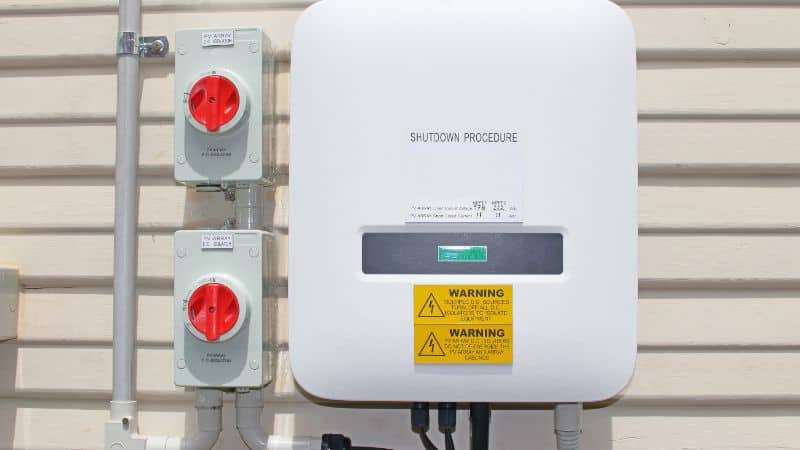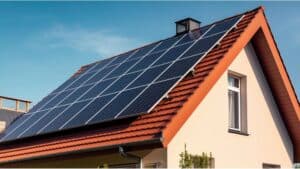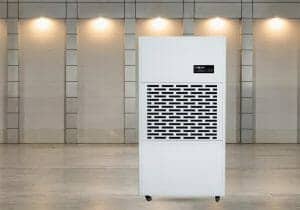Solar power is changing how we get electricity. A key part of this change is the hybrid solar inverter. This device enables people to use solar energy in smarter ways. It works with solar panels, batteries, and the power grid to give homeowners more control over energy use.
What is a hybrid solar inverter specifically? Check it out in this article.
Basic Understanding of a Hybrid Solar Inverter
A hybrid solar inverter is a key device in solar power systems. It combines the functions of a regular solar inverter and a battery inverter. This smart device manages electricity from multiple sources. It handles power from solar panels, batteries, and the utility grid.
Hybrid inverters convert DC electricity from solar panels into AC power for home use. They also control the charging and discharging of batteries. These inverters optimize energy flow and decide when to use solar power, store excess energy, or draw from the grid.
A main benefit is increased energy independence. Hybrid inverters allow homes to use stored solar power at night or during outages. They’re more efficient than separate inverters and battery systems. This can lead to cost savings and a simpler setup.
What are the Functions of a Hybrid Solar Inverter?
Hybrid solar inverters perform several key functions in solar power systems. These devices manage energy flow between solar panels, batteries, and the electric grid, which is very important in converting, regulating, monitoring, and maximizing power output.
-
DC-To-AC Bidirectional Power Conversion
Hybrid solar inverters convert direct current (DC) from solar panels into alternating current (AC) for home use. They also convert AC from the grid to DC for battery charging. This two-way conversion allows for flexible energy management.
The inverter sends excess solar power to batteries or the grid. When solar production is low, it draws power from batteries or the grid to meet demand. Some models can handle high-voltage DC input from solar panels. This reduces power losses and improves system efficiency.
-
Power Regulation
These inverters regulate voltage and frequency to ensure stable power output. They match the grid’s voltage and frequency when feeding power back to it.
Power regulation protects connected devices from damage due to voltage fluctuations. It also helps maintain grid stability when exporting excess solar energy. Advanced models offer features like reactive power control, which can help balance the local grid and reduce electricity costs in some areas.
-
Power Monitoring
Hybrid inverters track energy production, consumption, and storage in real-time. They collect data on solar panel output, battery charge levels, and grid power usage.
Many models have built-in displays or smartphone apps that can show system performance and energy flow diagrams. Users can see how much energy hybrid inverters are producing, using, and storing. Some inverters can even send alerts for system issues or maintenance needs, ensuring the solar system runs at peak efficiency.
-
Power Maximization
These devices use Maximum Power Point Tracking (MPPT) to get the most energy from solar panels. MPPT adjusts the electrical load to match the panels’ optimal operating point. Hybrid inverters can prioritize solar power use over grid power, and they may charge batteries with excess solar energy during the day for use at night.
Some models allow for expanding the solar system over time. They can handle additional panels or batteries as energy needs grow. Advanced inverters may use weather forecasts to optimize power management and prepare for cloudy days by ensuring batteries are fully charged.

Components of a Hybrid Inverter System
A hybrid inverter system integrates several parts to harness solar energy efficiently. These components work together to generate, store, and manage power for homes and businesses.
| Components | Description |
| Solar Panels | Solar panels capture sunlight and convert it into electricity, typically using silicon cells to produce DC power. The number of panels required depends on energy consumption and available space. |
| Battery Storage | Batteries store excess energy for later use, which is especially beneficial during cloudy days or power outages. Common types include lithium-ion, lead-acid, and saltwater batteries. |
| Inverter Unit | The inverter is the system’s brain, converting DC power from panels and batteries into AC power for home use. A hybrid inverter can charge batteries and draw power from the grid as needed. |
| Monitoring and Control Systems | These tools help users track and manage energy use, often through smartphone apps or web portals that display real-time power production, battery levels, and consumption patterns. |
Types of Hybrid Inverters
Hybrid solar inverters come in different types to suit various energy needs. These inverters manage power flow between solar panels, batteries, and the grid. Let’s explore the main types and their uses.
AC-Coupled Hybrid Inverters
AC-coupled hybrid inverters work with existing solar setups. They connect to the AC side of a solar system. This type is great for adding battery storage to solar panels already in place and they work well in areas with stable grid power.
AC-coupled inverters change DC power from batteries to AC for home use. They also convert AC from the grid to DC for battery charging. These inverters are flexible and easy to install.
AC-coupled systems can be more costly, but they offer simple upgrades for homes with solar panels.
DC-Coupled Hybrid Inverters
DC-coupled hybrid inverters connect directly to solar panels and batteries. They handle DC power from both sources before changing it to AC. This design is more efficient than AC-coupled systems.
These inverters reduce energy loss in power conversion. They’re ideal for new solar installations with battery storage. DC-coupled systems work better in places with frequent power outages.
Installation can be more complex. But they offer better performance in off-grid or unreliable grid situations. DC-coupled inverters are often cheaper for complete new systems.
Differences and Suitable Applications
The choice between AC and DC-coupled inverters depends on specific needs.
AC-coupled systems are better for:
- Adding batteries to existing solar setups
- Homes with stable grid connections
- Easier installation and maintenance
DC-coupled systems are ideal for:
- New solar and battery installations
- Areas with unreliable grid power
- Maximum energy efficiency
AC-coupled inverters offer more flexibility, while DC-coupled inverters provide better overall efficiency. Consider your energy goals, budget, and local grid reliability when choosing. For off-grid living, DC-coupled systems often work best. For grid-tied homes wanting backup power, either type can work well.
Comparison with Traditional Solar Inverters
Hybrid solar inverters differ from traditional inverters in several ways. Traditional inverters only convert DC power from solar panels to AC power for home use. Hybrid inverters can do this and more.
A major advantage of hybrid inverters is their ability to store excess energy in batteries. This allows homeowners to use solar power even when the sun isn’t shining. Traditional inverters can’t do this on their own.
Hybrid inverters also offer smart energy management. They can decide when to use solar power, battery power, or grid power. This helps maximize energy efficiency and savings.
Here’s a quick comparison:
| Feature | Hybrid Inverter | Traditional Inverter |
| DC to AC conversion | Yes | Yes |
| Battery storage | Yes | No |
| Smart energy management | Yes | No |
| Grid connection | Yes | Yes |
| Off-grid capability | Yes | No |
That is to say, hybrid inverters are more complex and costly than traditional ones. But they offer more flexibility and can be a good choice for those wanting energy independence. Traditional inverters are simpler and cheaper. They work well for basic solar setups without battery storage needs.

Considerations for Choosing a Hybrid Inverter
Several key factors need careful thought to ensure the best fit for your home and energy goals.
- Energy Needs and Consumption Patterns
Look at your electricity bills to see how much power you use daily. Check when you use the most electricity. Some homes use more power in the evening. Others have high daytime use. This affects how much solar power you can use right away versus store in batteries.
Think about future changes too. A growing family or new appliances can increase energy needs. Choose an inverter that can handle some extra demand.
- Budget and Cost Implications
Hybrid inverters can cost more upfront than standard ones. However, they often save money in the long run by storing extra solar power instead of sending it to the grid.
Compare prices from different brands. Look for warranties and after-sales support. A good warranty can save money on future repairs. Some areas offer rebates for solar systems with hybrid inverters. Check local incentives to lower your costs.
- Compatibility with Existing Solar Systems
For homes that already have solar panels, you should check out the compatibility. Not all hybrid inverters work with all types of panels. Check if your current panels match the inverter’s specifications.
Look at the voltage and current ratings of your panels. The inverter must handle these levels. Some inverters work better with certain panel layouts. Ask a solar pro to check if a hybrid inverter fits your setup.
If you plan to keep your current panels, make sure the new inverter can maximize their output.
- Future Scalability And Expansion
Choose an inverter that allows for growth. You might want to add more panels or batteries later. Some inverters make this easy, while others have limits.
Look for inverters with extra inputs for more panels. Check if they can handle more battery capacity too. This lets you expand your system without replacing the inverter.
Smart features are worth considering. Some inverters connect to home energy management systems. These can help you track and optimize your energy use over time. They might also work with future smart home devices.
Should You Invest in a Hybrid Solar Inverter
Hybrid solar inverters can be a smart investment for many homeowners. They offer flexibility by managing energy from solar panels, batteries, and the grid. If you need more electricity, want to be self-reliant, or may add batteries later, a hybrid inverter is a good choice for you.
These inverters shine during power outages as they keep your lights on when the grid goes down. This makes them great for areas with unreliable electricity. Cost is a key factor to consider. Hybrid inverters cost more upfront than standard ones. But they can save money long-term through better energy management.
If you are not sure about what to invest, talk to Deye solar professionals to assess your specific situation.
Deye is a recognized leader in the new energy inverter technology sector, known for its commitment to quality and innovation. The company has made significant strides in the market, particularly in energy storage inverters, with notable sales figures, including 97.2 million units sold overseas in 2020.
With a strong foundation in China’s vast market and advanced Internet technology resources, Deye has positioned itself as a prominent brand in the high-end environmental electrical appliance industry.
For those considering investing in solar technology, Deye’s hybrid inverters offer a smart solution for energy management, allowing you to optimize solar power use and enhance energy independence. Learn more about our hybrid solar inverters on our website and send us a message for further information.











